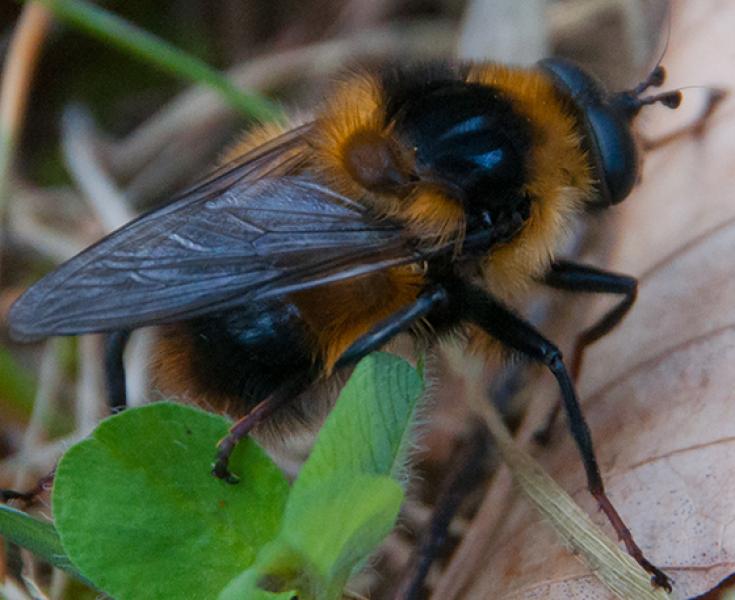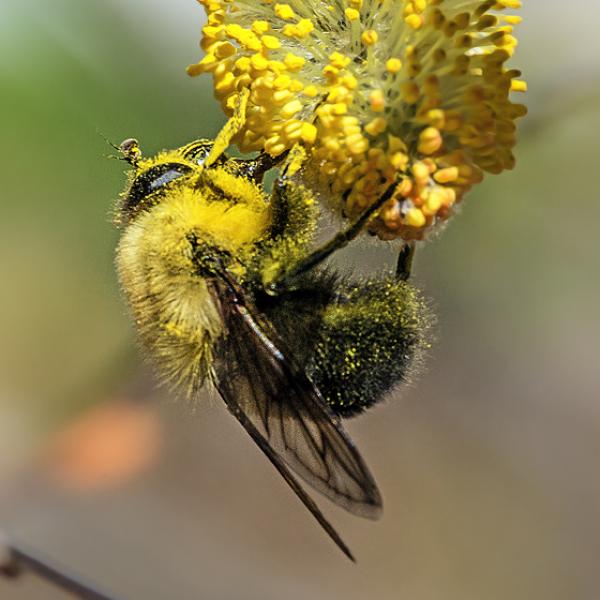Bare-cheeked Bumblefly
Criorhina nigriventris Walton, 1911
- Class
- Insecta (Insects)
- Family
- Syrphidae
- State Protection
- Not Listed
Not listed or protected by New York State.
- Federal Protection
- Not Listed
- State Conservation Status Rank
- S1
Critically Imperiled in New York - Especially vulnerable to disappearing from New York due to extreme rarity or other factors; typically 5 or fewer populations or locations in New York, very few individuals, very restricted range, very few remaining acres (or miles of stream), and/or very steep declines.
- Global Conservation Status Rank
- G5
Secure globally - Common in the world; widespread and abundant (but may be rare in some parts of its range).
Summary
Did you know?
These large flies are spot-on Bumblebee mimics.
State Ranking Justification
The Bare-cheeked Bumblefly is uncommon throughout its range (Skevington et al. 2019) and in New York it is known from just four occurrences in the central and southeastern portion of the state, only one of which is recent. It relies exclusively on old growth deciduous forests for breeding, a rare and threatened habitat.
Short-term Trends
The species was re-confirmed in the Catskills in May, 2017.
Long-term Trends
This species did not appear in an early comprehensive list of the insects of New York (Leonard 1928). It was first documented in the state in the late 1940s in the Finger Lakes region. Two other museum records from central NY came from the 1960s and seventies.
Conservation and Management
Threats
Like all saproxylic (dead wood) insects, this Hover fly is threatened by modern forestry and land management practices that remove trees from stands before they can reach old age because the partially decayed breeding sites within senescent trees take upwards of 100 years to form (Speight 2015).
Conservation Strategies and Management Practices
The presence of this species is a clear indication of old growth forest conditions. Forest management practices allowing long rotation times (more than 100 years) are required to allow deciduous trees to reach the advanced stage where suitable rot-holes can form (Speight 2015).
Research Needs
Very little is known about this species throughout its entire North American range. Research into any aspect of its biology would be a valuable contribution.
Habitat
Habitat
These arboreal canopy-dwelling flies are confined to old growth deciduous forests with senescent trees where the larvae live in rot-holes, root cavities and decaying heartwood. Because the larvae are filter feeders, conditions within the forest must remain stable and humid. Adults often descend in the evening to visit flowers and bask in sun flecks in canopy gaps. Sometimes they are also reported from bogs.
Associated Ecological Communities
- Appalachian oak-hickory forest
(guide)
A hardwood forest that occurs on well-drained sites, usually on ridgetops, upper slopes, or south- and west-facing slopes. The soils are usually loams or sandy loams. This is a broadly defined forest community with several regional and edaphic variants. The dominant trees include red oak, white oak, and/or black oak. Mixed with the oaks, usually at lower densities, are pignut, shagbark, and/or sweet pignut hickory.
- Beech-maple mesic forest
(guide)
A hardwood forest with sugar maple and American beech codominant. This is a broadly defined community type with several variants. These forests occur on moist, well-drained, usually acid soils. Common associates are yellow birch, white ash, hop hornbeam, and red maple.
- Black spruce-tamarack bog
(guide)
A conifer forest that occurs on acidic peatlands in cool, poorly drained depressions. The characteristic trees are black spruce and tamarack; in any one stand, either tree may be dominant, or they may be codominant. Canopy cover is quite variable, ranging from open canopy woodlands with as little as 20% cover of evenly spaced canopy trees to closed canopy forests with 80 to 90% cover.
- Hemlock-northern hardwood forest
(guide)
A mixed forest that typically occurs on middle to lower slopes of ravines, on cool, mid-elevation slopes, and on moist, well-drained sites at the margins of swamps. Eastern hemlock is present and is often the most abundant tree in the forest.
Associated Species
- Hairy-cheeked Bumblefly (Criorhina verbosa)
Range
New York State Distribution
It is known only from a few scattered locations in central and southeastern New York.
Global Distribution
This uncommon fly occurs in the northeastern US and Canada from North Carolina to Nova Scotia, west through the Great Lakes states and along the US/Canada border to central British Columbia and Alaska (Skevington et al. in press).
Best Places to See
- Catskills
Identification Comments
General Description
Criorhina are large (1.5- 2.0 cm) Bumblebee mimics with an anteroventrally produced face, haired arista (antennae) and bare metasturnum (cheek).
Identifying Characteristics
Within Criorhina, there is much color variation of pile (fly hair) from orangeish or golden to pale yellow, so beware of using this character alone. The larva is sub-cylindrical and short-tailed with internal mouth hooks. Behind each of the anterior spiracles lies a large laterally directed hook, looking like a pair of cow horns (Rotheray 1993).
Characters Most Useful for Identification
The single pair of wings, as well as the Dipteran shape and morphology of the eyes and antennae separate this fly from the Bumblebees that it mimics.
Best Life Stage for Proper Identification
Adult.
Behavior
Males can be found hilltopping where they search for females who can sometimes be sighted flying around the base of old deciduous trees investigating rot-holes for oviposition sites (Speight 2015).
Diet
The adults feed on pollen and nectar from Chamaedaphne, Salix, Ribes, Prunus. The larvae are saprophagous filter feeders within decaying heartwood of trees, including rot- holes, roots and old stumps. They are adapted for gathering and concentrating micro-organisms suspened in a fluid medium (Rotheray 1993; Skevington et al. in press).
Best Time to See
This is an early spring species, most likely to be observed in late April- May.
- Reproducing
- Larvae present and active
The time of year you would expect to find Bare-cheeked Bumblefly reproducing and larvae present and active in New York.
Similar Species
- Hairy-cheeked Bumblefly (Criorhina verbosa)
This species is very similar to Criorhina verbosa, but it flies somehwat later and the cheek is bare and the facial projection is shining.
Bare-cheeked Bumblefly Images
Taxonomy
Bare-cheeked Bumblefly
Criorhina nigriventris Walton, 1911
- Kingdom Animalia
- Phylum Arthropoda
(Mandibulates)
- Class Insecta
(Insects)
- Order Diptera
(Flies and Keds)
- Family Syrphidae
- Order Diptera
(Flies and Keds)
- Class Insecta
(Insects)
- Phylum Arthropoda
(Mandibulates)
Additional Resources
References
Leonard, M. D. ed. 1928. A list of the insects of New York, with a list of the spiders and certain other allied groups. Cornell University Agricultural Experiment Station Mem. 101. Ithaca, New York. 1121 pp.
Miranda, G.F.G., A.D. Young, M.M. Locke, S.A. Marshall, J.H. Skevington, and F.C. Thompson. 2013. Key to the genera of nearctic Syrphidae. Canadian Journal of Arthropod Identification No. 23 (August, 2013). Available online: http://cjai.biologicalsurvey.ca/mylmst_23/mylmst_23.html
New York Natural Heritage Program. 2024. New York Natural Heritage Program Databases. Albany, NY.
Rotheray, G.E. 1993. Color Guide to Hoverfly (Diptera, Syrphidae) Larvae in Britain and Europe. Dipterists Digest 9; 1-156.
Rotheray, G.E., F. Gilbert. 2011. The Natural History of Hoverflies. Forrest Text, Cardigan, UK.
Skevington, J.H., M.M. Locke, A.D. Young, K. Moran, W.J. Crins, S.A. Marshall. In press. Field Guide to the Hoverflies of Northeastern North America.
Speight, M. C. D.2015. Species accounts of European Syrphidae (Diptera), 2015 (Vol. 83). Dublin: Syrph the Net Publications.
Links
About This Guide
This guide was authored by: Jeffrey D. Corser
Information for this guide was last updated on: November 26, 2019
Please cite this page as:
New York Natural Heritage Program. 2024.
Online Conservation Guide for
Criorhina nigriventris.
Available from: https://guides.nynhp.org/bare-cheeked-bumblefly/.
Accessed July 26, 2024.

